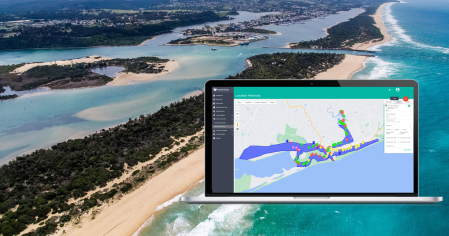Maintenance Management System Software

Maintenance Management System Software
Introduction
Infrastructure organisations across Australia face mounting pressure to maintain aging road networks and transportation assets while managing tight budgets and growing public expectations. Maintenance management system software has become essential for councils, state authorities, and private infrastructure operators seeking to optimise their asset performance and extend infrastructure lifecycles. These platforms transform how teams plan, execute, and track maintenance activities across vast road networks and transportation corridors.
At Asset Vision, we understand the unique challenges Australian infrastructure managers encounter daily. Our solutions help organisations shift from reactive maintenance approaches to proactive, data-driven strategies. If you’re looking to modernise your infrastructure maintenance operations, contact our team to discuss how we can support your organisation’s specific requirements.
This article explores how modern maintenance platforms are reshaping infrastructure management, the key capabilities organisations should prioritise, and practical considerations for selecting solutions that deliver lasting value.
The Evolution of Infrastructure Maintenance Technology
Australian infrastructure managers have witnessed remarkable changes in how maintenance operations are planned and executed over the past two decades. Traditional paper-based systems and disconnected spreadsheets have given way to integrated digital platforms that connect field crews, asset data, and decision-makers in real time.
The shift towards cloud-based solutions has particularly transformed operations for regional councils and state road authorities. These organisations can now access comprehensive asset information from any location, enabling faster response times and better resource allocation. Mobile technology has eliminated the need for manual data transfer, reducing errors and improving the accuracy of maintenance records.
This technological progression reflects broader changes in how Australian organisations approach infrastructure stewardship. The focus has moved from simply fixing problems as they arise to understanding asset condition trends, predicting future maintenance needs, and allocating resources where they deliver the greatest benefit to road users and communities.
Core Capabilities of Modern Maintenance Platforms
Effective maintenance management system software must address the full lifecycle of infrastructure assets, from initial construction through to renewal. The most valuable platforms integrate several critical functions that work together to support informed decision-making and efficient operations.
Work order management forms the foundation of most platforms, enabling organisations to create, assign, and track maintenance tasks across their road networks. This functionality connects office-based planners with field crews, ensuring everyone has current information about work requirements, asset locations, and completion status. Quality platforms allow teams to manage both scheduled preventative maintenance and reactive repairs within a single system.
Asset register management provides a central repository for all infrastructure information, including construction details, maintenance history, and current condition assessments. This capability becomes particularly valuable for organisations managing diverse asset types across multiple locations. Having this information readily accessible helps teams make informed decisions about maintenance priorities and resource allocation.
Mobile functionality enables field crews to access work orders, record completed activities, and capture asset condition information while on site. This eliminates the delays and errors associated with manual data transfer. Crews can photograph defects, record GPS coordinates, and add voice notes without returning to the office, improving both productivity and data quality.
Analytics and reporting capabilities transform raw maintenance data into actionable insights. Organisations can identify recurring problems, track contractor performance, monitor budget utilisation, and forecast future maintenance requirements. These insights support both operational improvements and strategic planning decisions.
Selecting the Right Platform for Your Organisation
Choosing maintenance management system software requires careful consideration of your organisation’s specific needs, existing systems, and long-term objectives. The decision extends beyond simple feature comparisons to encompass factors like implementation complexity, ongoing support requirements, and potential for future expansion.
Integration capabilities deserve particular attention. Your maintenance platform should connect seamlessly with existing enterprise systems, including financial management tools, GIS platforms, and data analytics solutions. This integration eliminates duplicate data entry, reduces the risk of inconsistencies, and provides a comprehensive view of asset performance and costs.
Scalability ensures your chosen solution can grow with your organisation. Consider whether the platform can accommodate increasing asset numbers, additional users, and expanded functionality as your needs evolve. This is especially important for councils experiencing population growth or organisations planning to consolidate multiple asset management systems.
User adoption often determines whether a maintenance platform delivers its promised benefits. Platforms with intuitive interfaces and minimal training requirements help ensure field crews and office staff embrace the new system. Look for solutions that match your team’s technical capabilities and work patterns rather than forcing significant process changes.
Comparison of Maintenance Platform Approaches
| Approach | Primary Strengths | Best Suited For | Key Considerations |
|---|---|---|---|
| Cloud-Based Platforms | Remote access, automatic updates, reduced IT infrastructure, scalability | Organisations seeking flexibility, multi-site operations, limited IT resources | Requires reliable internet connectivity, ongoing subscription costs |
| On-Premise Solutions | Complete data control, customisation options, one-time licensing | Organisations with specific security requirements, existing server infrastructure | Higher upfront costs, internal IT management responsibility |
| Hybrid Models | Combines cloud benefits with local data control, offline capability | Organisations with mixed connectivity environments, transitioning from legacy systems | More complex implementation, requires careful integration planning |
| Mobile-First Platforms | Field crew productivity, real-time data capture, reduced office time | Infrastructure organisations with large field teams, extensive road networks | May require robust mobile device management, connectivity planning |
How Asset Vision Supports Infrastructure Maintenance Operations
Our Core Platform provides Australian infrastructure organisations with comprehensive maintenance management system software specifically designed for transportation asset management. We’ve built our solutions around the real-world challenges faced by councils, state road authorities, and private infrastructure operators managing extensive road networks.
The platform integrates mobile work management capabilities that enable field crews to access work orders, update asset registers, and record maintenance activities from any location. Teams can work efficiently even in areas with limited connectivity, with data synchronising automatically once connection is restored. This approach eliminates the productivity losses associated with manual data transfer and duplicate entry.
Our CoPilot tool revolutionises road defect identification by enabling hands-free recording during inspections. Crews can capture defects with associated photographs, GPS locations, and voice notes without stopping their vehicles, significantly improving both safety and inspection coverage. This information flows directly into maintenance planning systems, supporting faster response times and better resource allocation.
AutoPilot takes automation further by using AI-powered image analysis to identify road defects automatically. The system captures and analyses images at regular intervals, detecting cracks, potholes, and other issues with accuracy that supports reliable maintenance planning. This technology enables organisations to monitor road conditions more frequently and comprehensively than traditional manual inspections allow.
Ready to transform your maintenance operations? Contact our team to discuss how our solutions can address your organisation’s specific infrastructure management challenges.
Implementing Maintenance Technology Successfully
Successful implementation of maintenance management system software requires more than technical configuration. Organisations must consider change management, staff training, and data migration to ensure their investment delivers expected benefits.
Begin by establishing clear objectives for what you want to achieve. Whether reducing maintenance costs, improving response times, or extending asset lifecycles, specific goals help guide both system configuration and ongoing use. These objectives also provide benchmarks for measuring success and identifying opportunities for refinement.
Data migration often presents the biggest challenge during implementation. Many organisations discover their existing asset information is incomplete, inconsistent, or stored across multiple systems. Developing a structured approach to data cleansing and consolidation before migration helps avoid carrying forward quality issues that undermine the new platform’s effectiveness.
Training should address both system operation and broader process changes. Field crews need practical, hands-on instruction that reflects their daily work patterns. Office staff require training on analytics, reporting, and workflow management. Ongoing support during the first months of operation helps teams build confidence and develop efficient working practices.
Future Directions in Maintenance Technology
Australian infrastructure organisations are increasingly exploring how emerging technologies can enhance their maintenance operations. Artificial intelligence and machine learning are moving beyond defect detection to predict maintenance requirements based on asset condition trends, usage patterns, and environmental factors.
Digital twin technology is creating virtual replicas of road networks that enable organisations to test different maintenance strategies, assess the impact of proposed works, and optimise resource allocation before committing to specific approaches. These digital models combine asset data, condition information, and performance metrics to support more sophisticated planning.
Integration between maintenance platforms and other smart infrastructure systems is expanding. Organisations are connecting maintenance data with traffic management systems, environmental monitoring, and community feedback platforms to develop a more complete understanding of asset performance and user needs. This integration supports decision-making that balances multiple priorities and stakeholder interests.
The shift towards predictive and prescriptive maintenance approaches will continue as organisations accumulate more asset condition data and develop sophisticated analytical capabilities. Rather than simply responding to identified problems, infrastructure managers will increasingly focus on preventing issues before they impact road users or require expensive reactive repairs.
Conclusion
Maintenance management system software has become fundamental to how Australian infrastructure organisations manage their road networks and transportation assets. These platforms enable the shift from reactive maintenance approaches to proactive, data-driven strategies that extend asset lifecycles, improve safety, and optimise resource allocation.
The most effective solutions integrate work order management, asset information, mobile capabilities, and analytical tools within a unified platform. They connect field crews with office-based planners, eliminate duplicate data entry, and provide the insights needed for informed decision-making. Success depends on selecting solutions that match your organisation’s specific requirements, existing systems, and future objectives.
As you consider how to enhance your maintenance operations, think about these questions: How could real-time asset condition information change your maintenance planning approach? What would it mean for your organisation to predict maintenance requirements before problems impact road users? How might integrated mobile and analytics capabilities improve both field crew productivity and strategic resource allocation?
We invite you to explore our solutions and discover how Asset Vision can help your organisation achieve its infrastructure maintenance objectives. Contact our team today to discuss your specific challenges and learn how our platform addresses the unique needs of Australian infrastructure managers.



